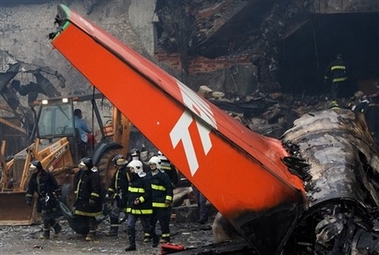Brazil plane crash may haunt government
(AP)Updated: 2007-07-19 08:42
SAO PAULO, Brazil - Brazil's deadliest jetliner crash was an accident foretold. For months, air safety concerns have been aired in congressional hearings, and pilots and traffic controllers have worried for years about the short, slippery runways at Brazil's busiest airport.
 Firefighters, left, carry remains from the crash of a TAM airlines commercial jet in Sao Paulo, Wednesday, July 18, 2007. [AP]  |
The runway appears to have been a key factor in Tuesday's crash, and critics condemned President Luis Inacio da Silva's government Wednesday for failing to invest in safety measures adopted by other urban airports.
None of the 186 people on board survived, TAM Linhas Aereas SA chief executive Marco Antonio Bologna said Wednesday. Three TAM workers on the ground also died and another 11 were hospitalized.
Firefighters pulled at least 171 charred bodies from the site where the Airbus-320 crashed, igniting in a 1,830-degree fireball. The plane slammed into a gas station and a TAM Airlines building after narrowly clearing the airport's perimeter fence and rush-hour traffic on a surrounding highway.
"What appears to have happened is that he didn't manage to land and he tried to take off again," said Capt. Marcos, a spokesman for the Sao Paulo Fire Department, who would not release his last name in accordance with department guidelines.
Also, video footage of the landing shows TAM Flight 3054 from Porto Alegre coming in faster than other planes, said Sen. Deonstenes Torres, chief of a Senate commission investigating problems with Brazilian civil aviation.
"On parts of the runway that most planes took 11 seconds to traverse, this plane took three," Torres said.
Torres said the plane's two black boxes would be sent the US for analysis. Meanwhile, French and US safety investigators are assisting the Brazilians in probing the cause of the crash.
International air safety experts have long warned of the danger of just such an accident on the short runway at Sao Paulo's airport, especially in heavy rain. Only the day before, two other planes skidded off the runway's end.
But Bologna said it was too early to say what went wrong.
"We have to wait for the results of the investigations to know the cause," he said. "It would be premature to make any assumptions about the runway."
Like many congested urban airports, Sao Paulo's domestic air travel hub is surrounded by development and has no room for the runway extensions recommended by air safety groups. New York's LaGuardia Airport, by contrast, has a 7,003-foot runway.
But the International Federation of Air Line Pilots' Associations said Wednesday the accident shows the need for the next best thing - braking systems of soft cement beyond the runway, where wheels can sink in and slow the jets to a safe stop.
The soft cement is strong enough to support airport emergency vehicles, but disintegrates into fragments when a heavy aircraft runs over it, thus acting as a brake.
Known as an arrestor bed, the system has prevented several planes from ending up in the bay next to New York's John F. Kennedy International Airport, said Gideon Ewers, the pilot group's spokesman.
Critics condemned Silva's government for its failure to fix Brazil's air traffic problems in the months since 154 people were killed in the September collision of a Gol Airlines Boeing 737 with a small jet over the Amazon rainforest.
"It's been 10 months since the last worst air accident in Brazilian history and now we've had an accident worse than that," said David Fleischer, a political scientist at the University of Brasilia. "If you look at what's happened since September, the answer is nothing."
"It was a tragedy foretold," said political commentator Lucia Hippolito. "The government has done nothing because of administrative inefficiency and simple incompetence."
Silva has been unable to wrest control of the civil aviation system from the military, which oversees Brazil's air traffic controllers and has filled top positions at the national aviation agency with political appointees with little or no experience.
Defense Minister Waldir Pires warned people not to point fingers.
"It's a moment for caution, and until the results of the investigation are known, it's better to maintain sobriety and avoid quick judgments," Pires said.
The accident is certain to have political ramifications, however, if only because the dead included Rep. Julio Redecker, 51, a leader of the opposition Brazilian Social Democracy Party and vocal critic of Silva's handling of the aviation crisis.
"President Lula needs to act and not speak. Or his term will be marked by the
suffering and pain of so many Brazilians that could be still be alive," read a
statement from Redecker's party.
| 1 | 2 |  |
|
|
|
||
|
||
|
|